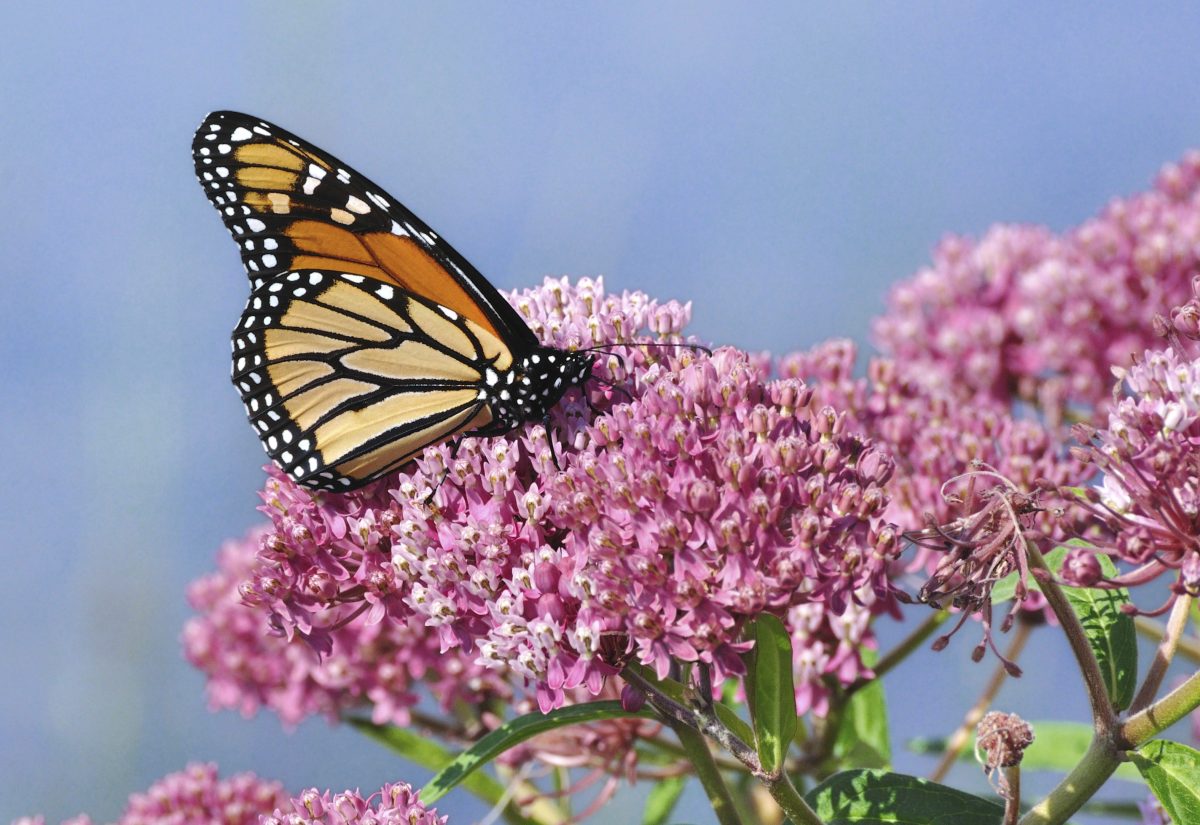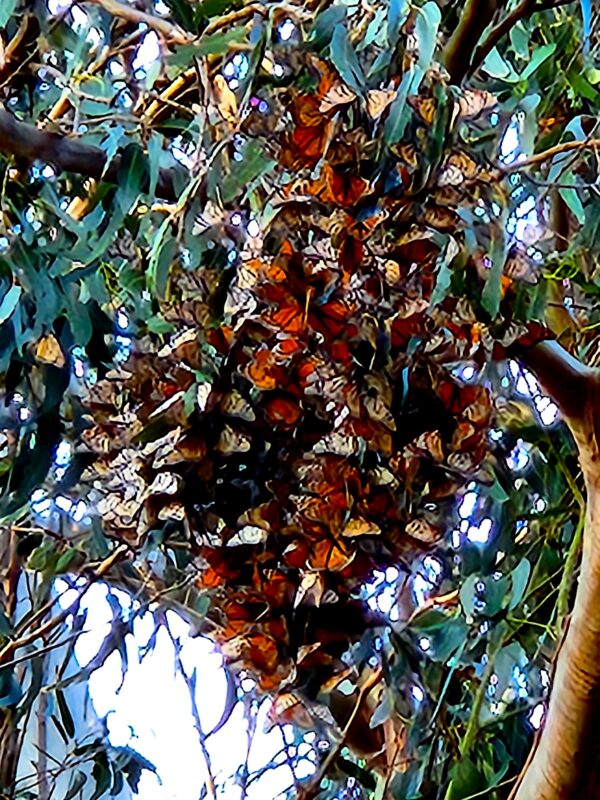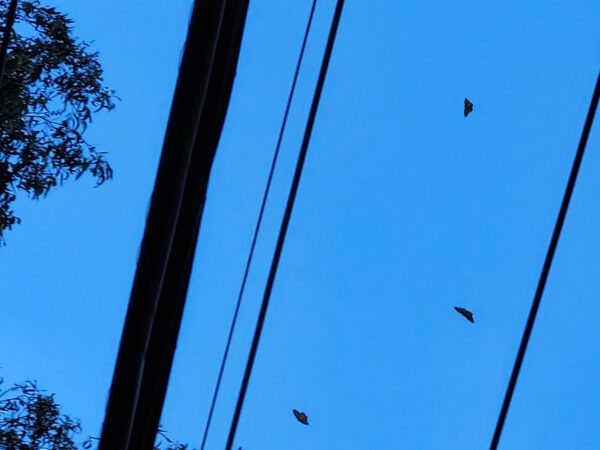


PISMO BEACH, Calif.—The monarch butterflies danced like red autumn leaves in the breeze among the treetops high above California’s Pismo Beach Monarch Garden Grove on Jan. 18.
It took a lot of work to spot them huddled in two large clusters hidden within the tall eucalyptus, basking in the late afternoon sun.
The monarchs had endured much since their arrival—torrential rains, floodwaters, toppled trees, cold snaps, and hungry predators.
Members of the Xerces Society monarch butterfly conservation group said it had been an unusually harsh overwintering season due to many factors, including climate change.
But the numbers are encouraging.
The society’s western monarch count last Thanksgiving reported 335,479 butterflies, up by nearly 100,000 from 2021.
“We can all celebrate this tally,” Emma Pelton, a conservation biologist at the Xerces Society and western monarch lead, said in a Jan. 31 announcement.
“A second year in a row of relatively good numbers gives us hope that there is still time to act to save the western migration.”
Still, Pelton said monarch conservation efforts have “a long way to go to reach population recovery” for the monarch.
Because of the fierce storms that hit right after Thanksgiving volunteers will have to start the spring counts with “far less than this total,” she said.
The Thanksgiving project involved more than 250 volunteers counting monarch butterflies at 272 overwintering sites along California’s central coastline between Nov. 12 and Dec. 4.
In 2021, volunteers counted nearly 250,000 butterflies.
While this season’s numbers are encouraging, they are well below the millions seen in the 1980s, signifying a weak recovery, according to the Xerces Society.
The November count reported over 130,000 butterflies in Santa Barbara and San Luis Obispo counties. Pismo Beach’s Monarch Butterfly Grove said it had the third largest count with 24,128 butterflies at season’s peak.
“Small populations are particularly vulnerable to being snuffed out by extreme weather, so we are lucky these storms occurred in a relatively good year,” Pelton said.
“We don’t want to count on luck alone to ensure the survival of the western monarch migration.”
Last summer, the International Union for Conservation of Nature (IUCN) placed the migratory monarch on the organization’s red list of threatened species. However, they are not yet endangered, which would grant them special federal protection.
The U.S. Fish and Wildlife Service anticipates the monarch receiving a federal listing in 2024.
“Overall, the IUCN decision does not affect how we continue to enact conservation for monarchs and other pollinators in the United States,” said Isis Howard, an endangered species conservation biologist at the Xerces Society.
“However, it’s very valuable in growing awareness about the conservation needs of monarchs and other at-risk pollinators.
Howard said typically the organization will notice a 30 to 50 percent decrease in monarchs between Thanksgiving and a follow-up New Year’s count.
Although it is difficult to state the exact reasons for winter declines, Howard told The Epoch Times, “we suspect this decrease is due to a combination of factors: mortality from winter storms, predation, and other factors as well as butterflies dispersing from the overwintering sites.”
Results of the New Year’s counts should be ready in February.
Howard said extreme weather forced countless monarchs out of their clusters at several overwintering sites. The butterflies are more susceptible on their own to the cold and wet and predators such as scrub jays and orioles.
“All this will negatively impact this spring’s breeding population, but how big of an impact is yet to be seen,” Howard said.
According to The Nature Conservancy, the monarch butterfly (Danaus plexippus) is common throughout North America and is easily recognizable by its brilliant orange and red wings with black veins.
The monarch begins its life as a tiger-striped caterpillar, feeding on milkweed before changing into a silky green chrysalis, from which an adult butterfly emerges through a process called metamorphosis.
“Monarchs serve an important role in regional ecosystems—not only as pollinators but also as a food source for other wildlife such as insects, some species of birds and rodents,” Howard said.
She said the monarch butterfly’s migration is unique and has evolved over thousands of years in North America.
During the overwintering period, the butterflies are abundantly found clustering in western states such as Arizona and California and further south in Mexico.
“Monarchs are inherently valuable and culturally significant to many peoples in North America. We don’t want to lose this incredible phenomenon on our watch,” Howard said.
“Monarch butterflies serve as a flagship species,” she added. “The declines in monarchs reflect declines in many other at-risk butterflies, bees, and other beneficial insects. Efforts to protect monarch butterflies and their habitat often benefit many other species.”
The National Wildlife Federation (NWF) attributed the slight increase in monarch numbers to coordinated conservation efforts.
The butterfly faces existential threats due to extreme weather and climate change.
“Climate change is taking a toll on the western monarch by damaging its overwintering grounds,” said NWF chief monarch recovery strategist Dr. Rebeca Quinonez-Pinion in a statement concerning the Xerces Society count.
“Joint efforts to reverse the western monarch declines should be steady, long term and primarily focused on restoring and conserving their breeding and overwintering native habitats through effective climate change strategies,” she said.
Howard said there needs to be more meaningful protection for the species and its habitat. Overwintering sites, in particular, are continually destroyed and damaged each year.
“If we lose overwintering sites in California, we could lose migratory western monarchs,” Howard said.
Howard said better management of land development, eucalyptus habitats, and tree trimming are essential to ensure survival of the monarch butterfly.




